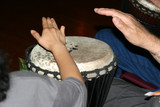Autistic Drum Therapy
For the parent, teacher or case manager responsible for a person
affected by autism, there is nothing more important than finding a way
to help and benefit the life-long struggles that those “on the
spectrum” face as they navigate through school and move into the adult
world. With the wellness effects of drumming and the inherent
structural benefits of a steady rhythm, drumming can help reach
autistic children on a fun and familiar level, giving them great music
and a way to interpret communications and improve their functioning
within a cooperative group environment.
One of the traits of
autism may include the child’s desire for structure. This may be in
their daily schedule or routine, in their preferred clothing, foods or
even music. Because of this need for structure, some occupational
therapists and other autism specialists have begun to incorporate
drumming into their
therapy sessions with autistic children.
The rhythms that are established while drumming are structured and
can be easily imitated, encouraging the autistic child or adult to
replicate a “normal” activity, but within a language that could perhaps
be better understood due to the repetitious rhythms. Drumming may be a
way for those affected by autism to
access the right side of their brain,
helping not only with socialization, but also with anxiety and
behavioral problems and opening up the typically logical and pragmatic
mind to more creative stimulus. Drumming also incorporates teamwork and
collaboration, and as such, can help teach autistic children (and
non-autistic children) how to work together.
Since drumming can give autistic children a voice and a means to
express emotions through rhythm, tone, speed and volume of drumming, it
can help them process their days and even assist in their ability to
communicate verbally. By modeling a rhythm played by a teacher or
therapist, or even having a “call and response” session, it is possible
that the sounds played mimic that of ordinary conversation. This can
help with conversational modeling, a hurdle for many children affected
by autism.
In drumming, the subtleties and nuances of emotion
are expressed in a less-subjective manner – fast drumming is exciting,
while slower rhythms naturally induce feelings of rest and relaxation.
Anger can be a loud beat and happiness becomes a joyful, less
structured rhythm played on multiple drums like congas or
bongos.
Drumming is also “cause and effect” and tactile, helping to integrate
sensory aspects into the therapeutic environment while it imitates
conversation.
The benefits of drumming for autistic children are
still being studied, and like most therapies, may not work for every
child. Providing new options and therapies to parents, caregivers and
case managers of autistic children are important since there is still
so much to learn about autism and what can help these children.
Recent Posts
-
X8 Drums Play-Along Backing Tracks
The new X8 Play-Along Series is being produced for our musician friends wanting a fresh way to work …9th Feb 2025 -
What is the Best Size Djembe for Beginners?
If you're new to the world of percussion and interested in learning the djembe, you're in for a t …16th Jul 2024 -
The Benefits of Becoming a Drumming Teacher: Transforming Passion into Profession
Why become a drumming teacher? Becoming a drumming teacher is an excellent way to share your pas …22nd May 2024



